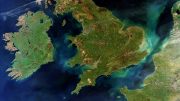The European Space Agency estimates there are 750,000 objects larger than 1 cm orbiting Earth. The risks from collisions are growing as the outer atmosphere becomes increasingly crowded, reports James Fitzgerald.
Most people wouldn’t step out onto a road with thousands of vehicles travelling at 40,000 km/h, and neither would they put an expensive piece of equipment in the way of such formidable traffic. But this is the scenario faced by space agencies as they launch multi-million dollar satellites into Earth’s orbit.
The European Space Agency estimates there are 750,000 objects larger than 1 cm orbiting Earth. Many will be fragments from collisions in space. About 18,000 of these projectiles are regularly monitored by existing surveillance systems, but the risks from collisions are growing as the outer atmosphere becomes increasingly crowded, with the prospect of large constellations of communication satellites entering the fray.
“Several thousand new satellites are planned for launch into low Earth orbit in the next few years,” says Marshall Kaplan of Launchspace Technologies. “That will make the debris problem much worse. At some point, no one knows when, there will be so many collisions that we won’t be able to operate safely in low Earth orbit anymore.”
The American company plans to send platforms the size of football pitches into low orbit to sweep up debris, which would also have sensors to track satellites and miscellaneous objects – potentially more accurately than ground-based systems.
Each orbital collision creates debris that further increases the chances of collisions in a cascade effect that was outlined by NASA scientist Donald Kessler in a 1978 paper. The “Kessler syndrome” will be on the minds of scientists, engineers, managers, space operators and policy-makers at the European conference on space debris later this month. Although there is a consensus among spacefaring nations about the need to mitigate effects from collisions and the cascade effect, it has become evident that remediation measures will be required to limit the number of objects in circulation.
Traditionally satellites facing retirement either meet a fiery end, after being directed into the lower atmosphere to burn out, or are elevated 200km above active satellites into a grave region. This will soon happen with Meteosat-7, a weather satellite that has a geostationary orbit 36,000km above the Indian Ocean.
However, even this zone may one day need to be cleared out.
“We recognise that the graveyard orbit can only be a temporary solution,” Milan Klinc, a flight dynamics engineer at EUMETSAT, recently told Space.com. “We are only in the early, theoretical stages at the moment, but we need to look at a permanent solution involving removing or collecting the old satellites.”
In March, during a spacewalk around the International Space Station (ISS), two NASA astronauts lost a thermal shield, which entered an orbit close to the station.
‘Peggy I don’t have a shield’: ISS astronauts lose key piece of equipment – video https://t.co/rl24K2dbZh
— The Guardian (@guardian) March 31, 2017
An amateur astronomer from the Netherlands photographed the shield using a Canon DSLR camera. The object appears as a faint, thin line, just ahead of the ISS. It is expected to drop out of orbit and burn up in the next few months.
“The item poses very little risk to navigation, and an accidental release like this is not unexpected given the complexity and challenges of working outside during a spacewalk,” says Holger Krag, head of the European Space Administration’s Space Debris Office.
The 7th European Conference on Space Debris will run from 18–21 April at ESA’s Space Operations Centre in Darmstadt, Germany, and will hear novel concepts on the active removal and surveillance of space junk. The issue of atmospheric re-entry survival and risks on the ground, as well as aspects of hypervelocity impacts in space, will also be discussed by experts.
It seems the sky will be the limit on possible solutions.




